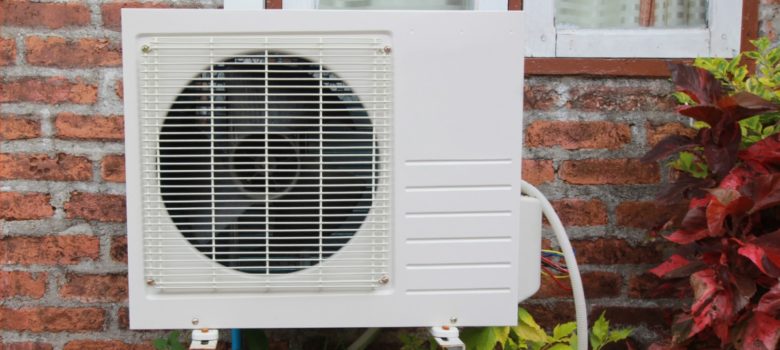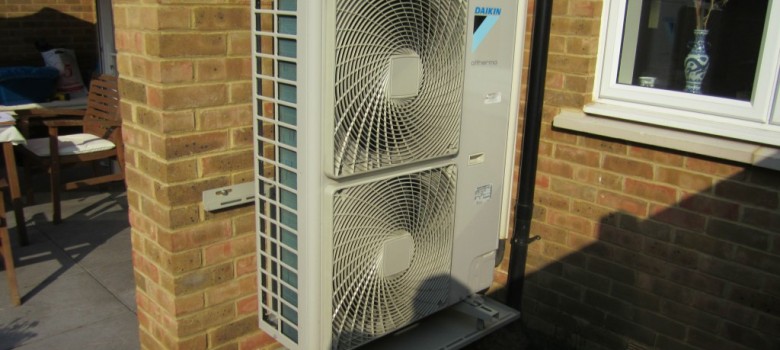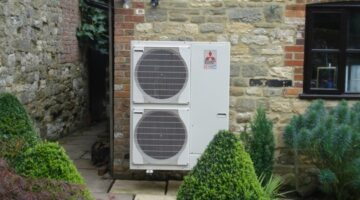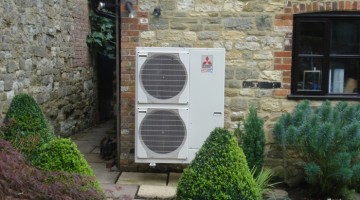
Planning where you install your air source heat pump carefully is very important in order for it to run at maximum efficiency. Clearly, a good installer will guide you on this, but we have compiled a few things you should be aware of:
Ground-level or suspended?

Where possible, the ASHP unit should be placed on the floor beside the property. This is best because firstly, it is easier to reach for servicing or maintenance. Secondly, pipework should be kept to to a minimum. Where it is not possible to fit a unit on the ground, it is possible to install it on brackets on the wall. In this case, just make sure it is not at head-height and that you can ensure access when needed.
Don’t cover up your ASHP
There’s no arguing with the fact that air source heat pumps are not the most beautiful of sights. As such, it might be tempting to try to hide it – but that’s not a good idea. We’ve seen plenty of ASHPs enclosed in their own little shed-like wooden structures, but the experts always say they should be out in the open. Air source heat pumps draw air through their sides and back, and kick cold air back out the front, once all the ambient heat has been extracted. If there’s something in front of it, this cold air can bounce off it and get sucked back in through the back and sides. An air source heat pump running on cold air isn’t going to do much! The manual of your individual unit will specify the minimum distance that must be kept clear in front of the unit.
Don’t put your ASHP indoors!
You can’t put an air source heat pump inside the house because it will effectively turn the room into a fridge. It will keep cooling the same air around it, until it can no longer extract any heat.
Planning permission for ASHP
In most cases, installing an air source heat pump is considered a small enough change to make it a ‘permitted development’ in domestic properties. The restrictions are as follows:
- The heat pump must comply with the Microgeneration Certification Scheme (MCS) Planning Standards (or equivalent).
- No other air source heat pump or a wind turbine has been installed on the
building (additional installations require planning permission). - The outdoor unit should be no bigger than 0.6 cubic metres and at least 1 metre
away from the site boundary. - Air source heat pumps installed on a flat roof should be within 1 metre of the roof
edge. Air source heat pumps installed on a pitched roof would require planning
permission. - In conservation areas and World Heritage Sites, heat pumps should be installed
at ground level and should not be fitted on a wall or roof which fronts a highway. - If your home is a listed building or on a site of a designed scheduled monument,
planning permission, and in some cases listed building consent, may be required.
Put your ASHP next to the house
There are a couple of reasons why air source heat pumps are normally placed next to the property. It reduces the length of pipework required between the unit and the house. As well as looking better and reducing trip hazards, this keeps efficiency at a maximum as it minimises heat loss through the pipes. To further reduce heat loss, pipes should be insulated with specialist external pipe lagging. Internal lagging will not be suitably weatherproof!
Be aware of noise
Air source heat pumps have a reputation for being a bit noisy. Although they’re normally not very loud, it might be worth not putting them right the other side of your neighbour’s wall, for the sake of conflict. You also might want to avoid putting it next to a bedroom – you would probably be able to hear a faint humming (like from a fridge) in an otherwise quiet house at night!
Siting your ASHP
For all the reasons above, where you put your ASHP will affect its efficiency, so its worth thinking about. Always use an MCS-certified installer and be sure they are happy with where you have chosen to place your unit.
Installing heat pumps
Are you thinking about getting a heat pump? We have scoured the country for the best tradespeople, so that we can make sure we only recommend those we really trust.
If you would like us to find you a local heat pump installer, just fill in the form below and we will be in touch shortly!













Good article, this is useful information! I decide to install an air source heat pump to provide ourselves with central heating and hot water. I think it will be a great alternative method of heating. Also I will save money on my gas bill, though my electric went up, but still it’s cheaper.
how far away and how high must a fence be in front of ahsp
It’s technically possible to put the heat pump indoors, you just need to duct the air into it from outside.
This removes the need for the unsightly external unit and might allow you to reduce noise pollution, by placing the unit in a properly soundproofed utility room.
Not that anyone seems to install them 🙁
Being able to have it ducted to outdoors would also allow people like me to have one in a flat where we are not allowed any conventional outdoor units
You’re missing a ‘not’ in the statement about flat roofs. They must NOT be installed within 1m of the edge of the roof according to the planning portal
https://www.planningportal.co.uk/info/200130/common_projects/27/heat_pumps/2
Indoor ASHP are common, the air is ducted in/out from the exterior of the house
placing of obstacle in front of air source heat pump how far away how high
If you could vent the cold air outside, then wouldn’t an indoor ASHP be more efficient? as the air it took in would be warmer, and being warmed by the radiators that it was heating, you’d need the right ventilation to allow replacement air to enter the house, but wouldn’t this be warmer than the air being extracted?
I have an air source heat pump however it seems to heat up the patio and dries out a path where the pipes are obviously laid under the patio , our hot water needs to be supplemented by using the immersion heater ! What can I do about it